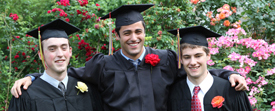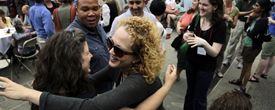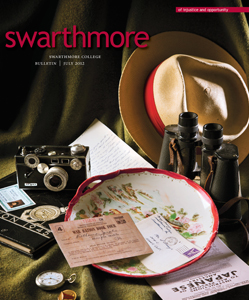By Carol Brevart-Demm

Ruth Dohi was excited. It was September 1942, and she was in a train, on her way to Swarthmore College. She was enjoying the ride—a long one, of more than two days—from Arizona to Pennsylvania. In a later letter, she wrote: “The fall leaves were quite lovely … and the countryside was most captivating and picturesque to my unaccustomed eye. … The staid but energetic atmosphere, the language, the temperament, and the people—all so very interesting and charming. I was very much thrilled to be in the East!”
Dohi’s excited anticipation is surely typical of generations of young people on the threshold of a college experience. Yet she was not typical. Dohi was one of more than 112,000 Americans of Japanese ancestry (Nikkei), including thousands of students, who during World War II were ordered by the United States government to evacuate their homes or campuses in the coastal areas of California and the Pacific Northwest to be interned in concentration camps further inland, away from the coast.
By Sherri Kimmel
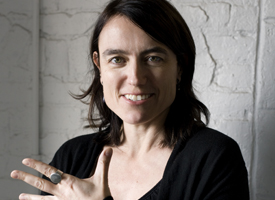
In these days of Instagrams, Instant Messenger, instant everything, paying attention to things that really matter is a tall order. And so several years ago, when Julia Haslett ’90 came across a quote by an obscure French philosopher/mystic, it was instant karma. “Attention is the rarest and purest form of generosity,” Haslett read. That line led the former Swarthmore English literature major on a six-year quest to document and understand the works and motivations of the author of that quote, Simone Weil. Weil died in 1943 at age 34, an apparent suicide by starvation.
By Carol Brevart-Demm
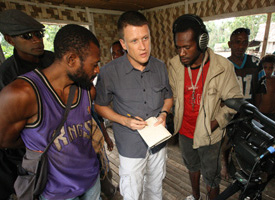
K. David Harrison is not a botanist. But walking through the Chilean rainforest with Teresa Maripan, he listened with fascination as she pointed out the tiniest details of the forest’s flora and explained the important ritual and medicinal uses of some of the specimens. Interesting as the facts about the mosses, leaves, flowers, and plants were, what really excited him was the language in which Maripan was describing them. Huilliche is spoken only in Chile’s Los Lagos and Los Rios regions by fewer than 2,000 people. Most of the Huilliche speakers are older adults, whose children mostly know only Spanish. Consequently, Huilliche is in decline. Harrison’s task—and the reason for his visit to the area—was to help preserve the language from extinction. When he’s not teaching linguistics as an associate professor at the College, rescuing endangered languages is what he does.
By Peter Slavin
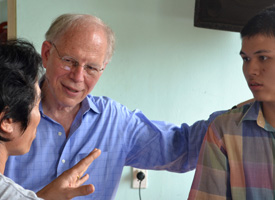
For years Charles Bailey ’67 has awakened every morning thinking about his job: how to restore the ruined fields, forests, and rice paddies and help the human casualties of Agent Orange in Vietnam. For the Vietnamese people, Agent Orange has been the lasting curse of what they call “the American War.”
Related Articles
By Rebecca Chopp

This spring Swarthmore and Lafayette Colleges jointly sponsored a conference, “The Future of the Liberal Arts in America and its Leadership Role in Education Around the World,” engaging more than 230 college presidents, provosts, and foundation and association officers from around the United States and the United Kingdom.
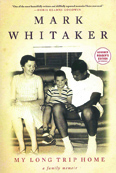
Mark Whitaker ’78 found that he had first to forgive, and then came understanding. It struck me that each reader of this arresting memoir would react differently to the Whitaker family history, but a common realization would be that for each examined life, there is the potential, almost the promise, of understanding and, given our shared capacities to hurt and be hurt, room for forgiveness.
By The Sherkites
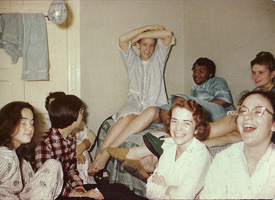
We freshmen in the Class of 1963 arrived at Swarthmore on a wave of euphoria born of freedom from parental control, the beauty of the campus, and the excitement of meeting talented peers from across the country. Quite soon, reality hit. All freshmen in those days had to take five full-credit courses. Each course, it seemed, required a staggering amount of work, especially the introductory courses in history and biology.
 Ruth Dohi was excited. It was September 1942, and she was in a train, on her way to Swarthmore College. She was enjoying the ride—a long one, of more than two days—from Arizona to Pennsylvania. In a later letter, she wrote: “The fall leaves were quite lovely … and the countryside was most captivating and picturesque to my unaccustomed eye. … The staid but energetic atmosphere, the language, the temperament, and the people—all so very interesting and charming. I was very much thrilled to be in the East!”
Dohi’s excited anticipation is surely typical of generations of young people on the threshold of a college experience. Yet she was not typical. Dohi was one of more than 112,000 Americans of Japanese ancestry (Nikkei), including thousands of students, who during World War II were ordered by the United States government to evacuate their homes or campuses in the coastal areas of California and the Pacific Northwest to be interned in concentration camps further inland, away from the coast.
Ruth Dohi was excited. It was September 1942, and she was in a train, on her way to Swarthmore College. She was enjoying the ride—a long one, of more than two days—from Arizona to Pennsylvania. In a later letter, she wrote: “The fall leaves were quite lovely … and the countryside was most captivating and picturesque to my unaccustomed eye. … The staid but energetic atmosphere, the language, the temperament, and the people—all so very interesting and charming. I was very much thrilled to be in the East!”
Dohi’s excited anticipation is surely typical of generations of young people on the threshold of a college experience. Yet she was not typical. Dohi was one of more than 112,000 Americans of Japanese ancestry (Nikkei), including thousands of students, who during World War II were ordered by the United States government to evacuate their homes or campuses in the coastal areas of California and the Pacific Northwest to be interned in concentration camps further inland, away from the coast.  In these days of Instagrams, Instant Messenger, instant everything, paying attention to things that really matter is a tall order. And so several years ago, when Julia Haslett ’90 came across a quote by an obscure French philosopher/mystic, it was instant karma. “Attention is the rarest and purest form of generosity,” Haslett read. That line led the former Swarthmore English literature major on a six-year quest to document and understand the works and motivations of the author of that quote, Simone Weil. Weil died in 1943 at age 34, an apparent suicide by starvation.
In these days of Instagrams, Instant Messenger, instant everything, paying attention to things that really matter is a tall order. And so several years ago, when Julia Haslett ’90 came across a quote by an obscure French philosopher/mystic, it was instant karma. “Attention is the rarest and purest form of generosity,” Haslett read. That line led the former Swarthmore English literature major on a six-year quest to document and understand the works and motivations of the author of that quote, Simone Weil. Weil died in 1943 at age 34, an apparent suicide by starvation.  K. David Harrison is not a botanist. But walking through the Chilean rainforest with Teresa Maripan, he listened with fascination as she pointed out the tiniest details of the forest’s flora and explained the important ritual and medicinal uses of some of the specimens. Interesting as the facts about the mosses, leaves, flowers, and plants were, what really excited him was the language in which Maripan was describing them. Huilliche is spoken only in Chile’s Los Lagos and Los Rios regions by fewer than 2,000 people. Most of the Huilliche speakers are older adults, whose children mostly know only Spanish. Consequently, Huilliche is in decline. Harrison’s task—and the reason for his visit to the area—was to help preserve the language from extinction. When he’s not teaching linguistics as an associate professor at the College, rescuing endangered languages is what he does.
K. David Harrison is not a botanist. But walking through the Chilean rainforest with Teresa Maripan, he listened with fascination as she pointed out the tiniest details of the forest’s flora and explained the important ritual and medicinal uses of some of the specimens. Interesting as the facts about the mosses, leaves, flowers, and plants were, what really excited him was the language in which Maripan was describing them. Huilliche is spoken only in Chile’s Los Lagos and Los Rios regions by fewer than 2,000 people. Most of the Huilliche speakers are older adults, whose children mostly know only Spanish. Consequently, Huilliche is in decline. Harrison’s task—and the reason for his visit to the area—was to help preserve the language from extinction. When he’s not teaching linguistics as an associate professor at the College, rescuing endangered languages is what he does.  For years Charles Bailey ’67 has awakened every morning thinking about his job: how to restore the ruined fields, forests, and rice paddies and help the human casualties of Agent Orange in Vietnam. For the Vietnamese people, Agent Orange has been the lasting curse of what they call “the American War.”
For years Charles Bailey ’67 has awakened every morning thinking about his job: how to restore the ruined fields, forests, and rice paddies and help the human casualties of Agent Orange in Vietnam. For the Vietnamese people, Agent Orange has been the lasting curse of what they call “the American War.”  This spring Swarthmore and Lafayette Colleges jointly sponsored a conference, “The Future of the Liberal Arts in America and its Leadership Role in Education Around the World,” engaging more than 230 college presidents, provosts, and foundation and association officers from around the United States and the United Kingdom.
This spring Swarthmore and Lafayette Colleges jointly sponsored a conference, “The Future of the Liberal Arts in America and its Leadership Role in Education Around the World,” engaging more than 230 college presidents, provosts, and foundation and association officers from around the United States and the United Kingdom.
 Mark Whitaker ’78 found that he had first to forgive, and then came understanding. It struck me that each reader of this arresting memoir would react differently to the Whitaker family history, but a common realization would be that for each examined life, there is the potential, almost the promise, of understanding and, given our shared capacities to hurt and be hurt, room for forgiveness.
Mark Whitaker ’78 found that he had first to forgive, and then came understanding. It struck me that each reader of this arresting memoir would react differently to the Whitaker family history, but a common realization would be that for each examined life, there is the potential, almost the promise, of understanding and, given our shared capacities to hurt and be hurt, room for forgiveness.
 We freshmen in the Class of 1963 arrived at Swarthmore on a wave of euphoria born of freedom from parental control, the beauty of the campus, and the excitement of meeting talented peers from across the country. Quite soon, reality hit. All freshmen in those days had to take five full-credit courses. Each course, it seemed, required a staggering amount of work, especially the introductory courses in history and biology.
We freshmen in the Class of 1963 arrived at Swarthmore on a wave of euphoria born of freedom from parental control, the beauty of the campus, and the excitement of meeting talented peers from across the country. Quite soon, reality hit. All freshmen in those days had to take five full-credit courses. Each course, it seemed, required a staggering amount of work, especially the introductory courses in history and biology.
